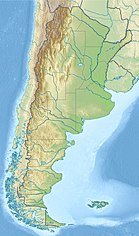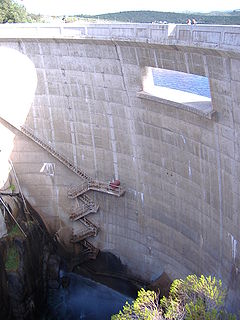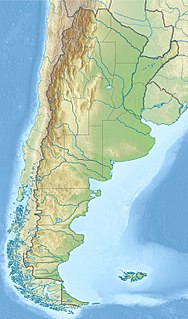| Los Molinos Dam | |
|---|---|
Downstream face of the dam | |
| Country | Argentina |
| Location | Córdoba |
| Coordinates | 31°49′6.16″S64°30′10.78″W / 31.8183778°S 64.5029944°W Coordinates: 31°49′6.16″S64°30′10.78″W / 31.8183778°S 64.5029944°W |
| Purpose | Power, water supply, flood control |
| Status | Operational |
| Construction began | 1948 |
| Opening date | 1953 |
| Owner(s) | Empresa Provincial de Energia de Cordoba (EPEC) |
| Dam and spillways | |
| Type of dam | Arch |
| Impounds | Los Molinos River |
| Height | 60 m (200 ft) |
| Length | 240 m (790 ft) |
| Reservoir | |
| Total capacity | 399×106 m3 (323,000 acre⋅ft) |
| Catchment area | 980 km2 (380 sq mi) |
| Surface area | 24.5 km2 (9.5 sq mi) |
| Los Molinos I | |
| Coordinates | 31°50′17.40″S64°26′46.81″W / 31.8381667°S 64.4463361°W |
| Commission date | 1956 |
| Turbines | 4 x 13 MW (17,000 hp) Francis-type |
| Installed capacity | 52 MW (70,000 hp) [1] |
The Los Molinos Dam (in Spanish, Dique Los Molinos) is a dam over the course of the Los Molinos River in the center-west of the province of Córdoba, Argentina, about 769 metres (2,523 ft) above mean sea level.

A dam is a barrier that stops or restricts the flow of water or underground streams. Reservoirs created by dams not only suppress floods but also provide water for activities such as irrigation, human consumption, industrial use, aquaculture, and navigability. Hydropower is often used in conjunction with dams to generate electricity. A dam can also be used to collect water or for storage of water which can be evenly distributed between locations. Dams generally serve the primary purpose of retaining water, while other structures such as floodgates or levees are used to manage or prevent water flow into specific land regions. The earliest known dam is the Jawa Dam in Jordan, dating to 3,000 BC.

Argentina is subdivided into twenty-three provinces and one autonomous city, Buenos Aires, which is the federal capital of the nation as decided by Congress. The provinces and the capital have their own constitutions, but exist under a federal system.

Argentina, officially the Argentine Republic, is a country located mostly in the southern half of South America. Sharing the bulk of the Southern Cone with Chile to the west, the country is also bordered by Bolivia and Paraguay to the north, Brazil to the northeast, Uruguay and the South Atlantic Ocean to the east, and the Drake Passage to the south. With a mainland area of 2,780,400 km2 (1,073,500 sq mi), Argentina is the eighth-largest country in the world, the fourth largest in the Americas, and the largest Spanish-speaking nation. The sovereign state is subdivided into twenty-three provinces and one autonomous city, Buenos Aires, which is the federal capital of the nation as decided by Congress. The provinces and the capital have their own constitutions, but exist under a federal system. Argentina claims sovereignty over part of Antarctica, the Falkland Islands, and South Georgia and the South Sandwich Islands.
Contents
The dam gathers the flow of a 980 square kilometres (380 sq mi) catchment basin. Its wall is 60 metres (200 ft) high and 240 metres (790 ft)long. The reservoir has a surface area of 24.5 square kilometres (9.5 sq mi) and a volume of 399 million cubic metres (323,000 acre⋅ft); the maximum depth of the water is 57 metres (187 ft).

A drainage basin is any area of land where precipitation collects and drains off into a common outlet, such as into a river, bay, or other body of water. The drainage basin includes all the surface water from rain runoff, snowmelt, and nearby streams that run downslope towards the shared outlet, as well as the groundwater underneath the earth's surface. Drainage basins connect into other drainage basins at lower elevations in a hierarchical pattern, with smaller sub-drainage basins, which in turn drain into another common outlet.
The dam was built between 1948 and 1953, and its primary goals are the regulation of the flow of the river and the production of hydroelectricity. The power station generates 52 megawatts (70,000 hp) for the Center Region of the Argentine Interconnection System.

Hydroelectricity is electricity produced from hydropower. In 2015, hydropower generated 16.6% of the world's total electricity and 70% of all renewable electricity, and was expected to increase about 3.1% each year for the next 25 years.
The reservoir is bordered by Provincial Route 5. It is employed for fishing (silverside), swimming, water skiing and sailing.

Fishing is the activity of trying to catch fish. Fish are normally caught in the wild. Techniques for catching fish include hand gathering, spearing, netting, angling and trapping. “Fishing” may include catching aquatic animals other than fish, such as molluscs, cephalopods, crustaceans, and echinoderms. The term is not normally applied to catching farmed fish, or to aquatic mammals, such as whales where the term whaling is more appropriate. In addition to being caught to be eaten, fish are caught as recreational pastimes. Fishing tournaments are held, and caught fish are sometimes kept as preserved or living trophies. When bioblitzes occur, fish are typically caught, identified, and then released.

Water skiing is a surface water sport in which an individual is pulled behind a boat or a cable ski installation over a body of water, skimming the surface on two skis or one ski. The sport requires sufficient area on a smooth stretch of water, one or two skis, a tow boat with tow rope, three people, and a personal flotation device. In addition, the skier must have adequate upper and lower body strength, muscular endurance, and good balance.

Sailing employs the wind—acting on sails, wingsails or kites—to propel a craft on the surface of the water, on ice (iceboat) or on land over a chosen course, which is often part of a larger plan of navigation.


















